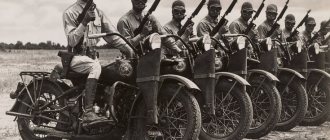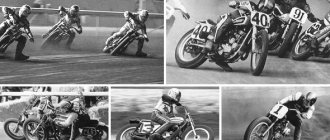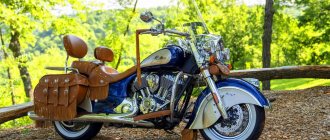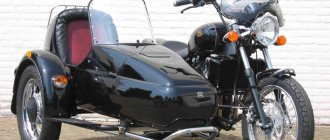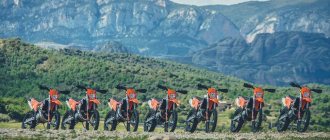MY MOTORCYCLE
Having appeared at the end of the last century as a fundamentally new vehicle taking its first steps, by the beginning of the second decade of our century the motorcycle could already give odds to carts, horses and cars. It is not surprising that when the world war broke out, the motorcycle took an active part in supporting combat operations on the continental fronts. Good experience is not wasted, and, having recovered from the consequences of war and economic crises, the leading countries of Europe began to actively improve technology, keeping in mind its military use. European armies actively (and, most importantly, noisily!) rattled weapons, ammunition and all sorts of improvised iron.
DKW RT 100 In the coming hostilities (no one doubted that they would happen, they only argued about who was with whom and against whom), the motorcycle had a very special role. If in the First World War it performed mainly auxiliary functions (communications, support, transportation of the wounded), then in the coming war of motors, despite the fact that the cavalry had not yet been completely written off, many of its functions were transferred to the newly created motorcycle units.
It is unlikely that in any army in the world there were special motorcycle units larger than a regiment. Separate companies and battalions were included in tank and mechanized units for reconnaissance and direct support of heavy equipment. Radio stations, machine guns, and mortars were installed on motorcycle sidecars. There were options for protecting strollers with armor plates; sometimes a motorcycle with a sidecar was covered entirely with armor. Well, of course, communications and support services, as well as patrol units, simply required the efficiency and maneuverability inherent in two-wheeled vehicles.
The main combat unit of motorcycle units was a platoon. The average structure of such a platoon, according to various sources, included four sections of nine people with one light machine gun, eight scouts and a commander with a gunner. But each squad had three motorcycles with sidecars, each scout had a single motorcycle, and the platoon commander traveled in an armored vehicle with machine gun armament.
A motorcycle company could consist of three light machine gun platoons and one heavy machine gun platoon. Not counting support and communications equipment, such a company, with up to 160 personnel, had about 60 motorcycles, and was armed with nine light and four heavy machine guns, not counting carbines, and later machine guns. As we can see, this was a force with which it was not recommended to joke. German analysts calculated that if the marching speed of an infantry battalion at that time was about 4 km/h, of cavalry - 6-8 km/h, then motorcycle units on the march could move at an average speed of up to 60 km/h! The first experience of using motorcycles in combat on the eve of the Second World War was the events in Spain in 1936-1939. And although motorcyclists there performed purely coherent functions, their advantages were obvious. Of course - after all, on good roads and with a Spanish temperament to boot, the signalmen reached speeds of up to 100 km/h! What happened next? And then, having fallen into a military trap, Europe was no longer able to get out of it. Less than six months had passed since the last soldiers of the Spanish Republic were interned in France, when motorized units of the Wehrmacht rushed to Warsaw. All countries that produced motorcycles were gradually drawn into hostilities...
DKW NZ 350
Let's try to imagine pre-war motorcycle Europe. Great Britain with its classic single-cylinder four-stroke motorcycles, Germany, whose calling card by that time had long been not only boxer motorcycles, but also numerous two-stroke DKWs of various cubic capacities; France, about whose extensive motorcycle program in the pre-war period we still do not know much; Italy, where engineering research sometimes led engineers and manufacturers in completely unimaginable ways... And then there were Austria and Belgium, Denmark and Czechoslovakia - motorcycles from these countries occupy a worthy place in all encyclopedias; There was Poland, which did not have a developed motorcycle industry, but made its own motorcycles (and good ones) for the army. The design thought of the Land of Soviets followed its own strange path. Let’s supplement the list with Switzerland and Sweden - “neutral” countries that did not fight (which did not stop Sweden from trading left and right in weapons and ball bearings), but produced their own motorcycles for the army and police. And in conclusion, let us mention that by that time overseas they were firmly convinced that the V-Twin engine was the best that could be.
“Happy is the state that, during times of peace, prepares for war,” says the ancient wisdom. Motorcyclists were preparing, and so were the manufacturers. Regardless of design research, almost all armies that fought had models with 350cc engines, both two- and four-stroke. The second group were medium and heavy four-stroke (with rare exceptions) motorcycles with engines of 500-750 cc, used both with sidecars and in a single version, and the third were machines specially designed for use in military operations, regardless of design the engine and the entire motorcycle as a whole. However, as we know from world history, war not only does not choose roads, but also confuses the maps. Over time, many light civilian motorcycles that were not intended for this purpose ended up in the war.
James ML 125
A few words about small-capacity motorcycles. They were used mainly in the German army, and there is no way to list them all. Many models DKW, Ardie, Victoria, Maico were used. Most of them were two-stroke, with a block motor (and the motors also had a deflector on the piston), with light tubular frames, they looked very pathetic when guys with machine guns piled on them. The 125 cc James and Royal Enfield also looked very extravagant in parts of the British Expeditionary Force in France and especially in the Algerian desert.
"DKW KS 200" Motorcycles with engines of 200-250 cc. cm looked more solid. They were also widespread in the Wehrmacht, and varied greatly in design. The two-stroke “DKW KS 200” or “NZ 250” were no different from civilian ones except for their coloring. The overhead valve NSU 251 QSIL had an open frame and was equipped with luggage boxes and other accessories.
BMW R20
The BMW R20 and R 23, as expected, had a cardan drive of the rear wheel, overhead valves and a tubular duplex frame, but the two-stroke Puch 250 S4 and Triumph BD 250 had two-piston engines. "Puch", in addition, had a clutch in the rear wheel hub. The Triumph had a normal layout, but the rear chain was in a sealed casing, and the engine had an inlet spool. Add to all this a certain number of cars from less well-known companies, including French, Belgian and Czech - that’s how much army repairmen needed to know!
Puch 250 S4 A class of motorcycles with engines with a displacement of 350 cc. sm in the pre-war period was very numerous. Basically, four-stroke engines with overhead valves were widely used. Low-valve cars could no longer meet the requirements and gradually disappeared from the scene.
Motorcycles of this size were not developed specifically for combat operations—it was easier to adapt existing models. Adaptation came down mainly to equipping the motorcycle with additional bags, shields and all sorts of small devices such as special air filters. True, there were exceptions. The Austrian model “350 GS” was known even before the war. Thanks to the overhead exhaust system and elastic rear wheel suspension, it could often be seen at the start of cross-country competitions. The motorcycle, like many of its “relatives,” had a two-piston engine and a clutch in the rear wheel hub. The difference was that the cylinders were located not across, but along the frame, one after the other, and each piston had its own connecting rod, and not the famous Pukhov “fork”. So, when preparing the military model of this motorcycle, the designers resorted to such a radical means as... a rigid rear suspension. If earlier both pistons were slightly different in diameter, now they are the same. The exhaust pipes went down, and instead of a high-voltage coil, a magneto appeared in the ignition system. A standard German headlight was also installed.
DKW RT 125-1 DKW (perhaps the only continental company) was able to carry out some modernization already in the middle of the war. The RT 125-1 and NZ 350-1 models went to the front. The latter differed from the previous modification in that the generator was completely “hidden” in the engine crankcase. In fact, it was this “front-line” development that became the basis for our post-war IZH-350.
Zundapp DS 350 The remaining motorcycles of the German Wehrmacht (those that were produced) arrived at the front without major changes, like the BMW R35 or Zundapp DS 350. However, there were few of the latter in the troops, although the car deserves a few words. It had a collapsible open frame made of tubular and stamped profiles, an overhead valve engine in a block with a four-speed gearbox, which were part of the power system of the frame. The push rods were located on both sides of the cylinders - one in front, the other behind. The front fork springs, unlike other models of the company, worked in tension, and there was also one adjustable hydraulic shock absorber from the KS 600 model. Let us note by the way that German motorcycles that have survived to this day and were prepared for the front can be distinguished by the presence on the steering column of the frame of a small horizontal sign indicating that “the motorcycle is prepared according to group III,” that is, for the army. The Wehrmacht also encountered “conquered” French or Belgian motorcycles, such as “Peugeot”, “Terrof”, “FN”, etc. But there were few of them. Most of it was left to the troops of the puppet government of General Pétain, and no mass requisition of transport was carried out there.
Ariel In the British army, "three hundred and fifty" were a very common class. The overhead valve “Ariel”, “Norton”, “Triumph”, “Velossete”, “Matchless” and many others received an additional rear seat, luggage pouches, a headlight visor - and “go ahead and sing.” Motorcycles delivered to the African theater of operations had the lower right part of the gas tank, located above the carburetor, slightly shortened. A pipe from a simple air filter mounted on the tank passed through this place. There were also lower valve motorcycles.
Matchless G3/L Of all the British cars of this class, only the Matchless G3/L and AJS underwent serious modernization during the war, which received a telescopic front fork in the middle of the war instead of the traditional parallelogram one.
AJS But mostly “five hundred” went to the Italian army. There is only a mention of the “Gilera RE 350”, by the way, a lower valve, the first version of which appeared already in 1926.
However, it was not these machines that bore the main burdens of wars. Heavier motorcycles were initially prepared directly for combat operations……..
to be continued…….
History of military motorcycles
Man has always sought to use any means of transportation for military purposes. At first it was horses and chariots, and as soon as the motorcycle appeared, it also began to be used in battle. It is generally accepted that the first military motorcycle, the Motor Scout, was created by Frederick Sims. It was introduced in 1898. It had four(!) wheels, a bicycle frame and saddle, a one-and-a-half-horsepower De Dion-Bouton engine, a Maxim machine gun and an armored shield that protected the driver’s chest and head. Motor Scout could carry 450 kilograms of equipment and fuel, which was enough for him to travel 120 miles. The brainchild of Frederick Simsom did not receive serious distribution in the army.
World War I
By the beginning of the First World War, motorcycles were already firmly established in the army and were in service with all progressive countries. Motorized equipment was supposed to replace horses, so the first to use it were couriers and messenger soldiers. Germany The first motorcycles, reinforced with machine guns, appeared in the German army. Unlike Sims's invention, these were modernized civilian motorcycles that were not well armored. It is worth noting that attempts to create an armored motorcycle continued until the fifties of the 20th century, but did not lead to anything. Despite this drawback, German “mobile machine gun emplacements” were successfully used in some operations on the fronts of the First World War.
The next step in the development of military motor vehicles was the quite logical appearance of mobile air defense systems. Aviation has ceased to be used only for reconnaissance and has begun to be used on an equal basis with other equipment in combat operations. In this regard, there was a need to repel attacks from the air, for which large-caliber machine guns were installed on motorcycles. Unfortunately, throughout the First World War, the motorcycle rarely saw action on the battlefield. His main occupation was transportation of the wounded, courier service and prompt delivery of various goods, including fuel for other equipment.
Post-war fever
After the end of the First World War, all participating countries, having appreciated all the advantages of motorcycles on the battlefield, began to develop new types of motorcycles. Many of them were too futuristic for their time. For example, in 1928 the French introduced the new Mercier motorcycle. Its main difference from other colleagues in the workshop was the front caterpillar wheel, which for that time seemed to be a very fresh idea. Later, in 1938, also a Frenchman, engineer Leître, introduced his motorcycle called Tractorcycle. As the name suggests, Leêtre modernized the 1928 model by making his motorcycle entirely crawler-mounted. It would seem that light armor and high cross-country ability should have made this model an ideal military motorcycle, but there were a number of serious shortcomings: heavy weight (400 kilograms), low speed (with a 500 cubic centimeter engine it reached a speed of only 30 km/h) and poor handling. Since the motorcycle was turned by bending the track, the motorcycle was extremely unstable when turning. Leêtre later added side wheels to his design, but the army was never interested in his development.
A non-standard model of a military motorcycle was also created in Italy. Guzzi designers presented a tricycle equipped with a machine gun and the same armored shield, but the distinctive feature of this motorcycle was that the machine gun was pointed backwards and there was no way to deploy it.
Belgium also tried to create something original, and in 1935 the FN concern succeeded. Belgian designers presented a simpler model of the M86 armored motorcycle. Compared to other European “colleagues,” the M86 turned out to be successful: the motorcycle was equipped with a forced 600 cubic centimeter engine, a reinforced frame, and armor plates that covered the motorcycle and the driver on the sides and front. The M86 could also carry a fully armored sidecar, on which a Browning machine gun was mounted. During the entire production period, about 100 similar motorcycles were produced, which were in service with countries such as Romania, Bolivia, China, Venezuela and Brazil. Unfortunately, not a single copy has survived.
In addition to various ideas that were poorly suited for life, the “ordinary” motorcycle industry also developed. This was especially noticeable in Germany. After the end of the First World War, under the terms of the peace treaty, Germany was prohibited from producing all types of weapons, but there was not a word about motor vehicles. In this regard, the real dawn of motorcycle construction began in Germany. The main factor for the development of this area was that a motorcycle could be purchased by the average resident of a devastated country, while a car remained the preserve of the rich. This is what prompted BMW to switch from producing spare parts for trains to motorcycles and enter into competition with the second major motorcycle manufacturer in Germany, Zundapp.
At first, BMW did not introduce anything new, installing the M2 B15 boxer engine on their motorcycles, which actually copied the English Douglas engine, but by 1924, engineers presented the first production motorcycle, the BMW R32, created from scratch.
But time passed, and from the beginning of the 1930s, the Bavarian concern realized the need to create a specialized military motorcycle. This is exactly what the BMW R35 became. Unlike its predecessors, it had a telescopic front fork and a more powerful engine with a capacity of 400 cc. An important point for the army was the cardan drive, which was distinguished by its high wear resistance relative to the chain drive. Of course, the R35 also had “old sores”, for example, a rigid rear suspension. Sometimes the frame would burst under heavy loads, but this did not prevent the R35 from getting into service. This motorcycle was successful both in the infantry, motorized units and medical battalions, and in the police. Production of the BMWR35 continued until 1940, after which it gave way to highly specialized military motorcycles.
At the same time as the R35, BMW released the R12. In fact, it was an improved version of the R32. The motorcycle had a 745 cc engine and telescopic forks with hydraulic shock absorbers, which made it a class higher than the R35. When creating the military version of the R12, one of the two carburetors was removed from the design, which reduced power from 20 horsepower to 18. Thanks to its low price and good performance, the R12 model became the most popular motorcycle in the German army. From 1924 to 1935, 36,000 of these motorcycles were produced. Like most BMW motorcycles, the R12 was produced both “solo” and with a sidecar. When it was produced, it was curious in that it did not have a single weld and had a specially designed spring for careful transportation of the wounded.
In addition to BMW, the aforementioned Zundarr motorcycle concern also took part in the industrial race, which also carried out government orders. Zundarp supplied three main models: K500, KS600 and K800. The K800 model with a sidecar was very popular among soldiers. Due to their low cost, they easily found their way into service, but of the entire line presented by Zundapp, only the K800 could compete with the BMW R12. The K800 was also interesting because it was the only four-cylinder model in service in the German army. This feature was partly a disadvantage, since the rear cylinders of the K800 were poorly cooled, which led to frequent oiling of the spark plugs.
In Russia, during and after the end of the First World War, there was practically no motorcycle production of its own. This continued until the 1930s. It was then, at the time of the technical re-equipment of the Red Army, that the need arose for their own motorcycle, which could withstand all the hardships of the Russian weather. The first domestic motorcycles specially developed for the army were the L300 and KhMZ 350. In fact, the KhMZ 350 was a copy of the American Harley-Davidson, but the Russian analogue was much inferior in quality to the Western motorcycle, and it was decided to abandon it. It was replaced by the TIZ-AM600, produced since 1931. This motorcycle was developed and supplied only to the army. Being a combination of Harley and some British influences, the TIZ-AM600 was the domestic car industry’s own development, although not particularly outstanding.
In 1938, domestic design bureaus presented several models at once: Izh-8, Izh-9 and L-8. The most striking and successful among the presented motorcycles was the L-8. The relatively powerful overhead valve engine of 350 cubic centimeters was the pride of the domestic motorcycle industry. But despite the fact that the L-8 model was produced at several factories throughout Russia, the motorcycle did not meet all the needs of the army. This was due to the fact that each plant made its own amendments to the motorcycle design, which led to a lack of unification in spare parts and turned into a serious problem in combat conditions.
The Second World War
Kraftrad (“power wheel”) is what the German army called motorcycles. This is where the abbreviation “Krad” or the letters “K” and “R” came from in the designation of some motorcycles. But first things first.
Since 1940, real reforms began in the German army. Despite the success of almost all pre-war BMW and Zundarp models, the command demanded a completely new class from manufacturers: heavy motorcycles. The first and only of their kind were two motorcycles: the BMW R75 and the Zundapp KS750. These were “draft horses” specially designed for off-road travel. Equipped with sidecar wheel drive and special off-road speed, both motorcycles have proven themselves extremely well. However, due to the high price, these motorcycles were supplied first to the Afrika Korps and parachute units, and after 1942 to the SS troops. Also in 1942, it was decided to produce a new, improved Zundapp KS750 motorcycle with a BMW 286/1 sidecar, but, unfortunately, this model never saw the light of day. Its production was supposed to begin after fulfilling an order for the production of 40 thousand R75 and KS750, of which only about 17 thousand were produced during the entire war.
The Sd half-track motorcycle became something completely new for the German army. Kfz. 2, known as Kettenkrad. Produced from 1940 to 1945, the Kettenkrad was designed to transport light guns and was more of a tractor than a motorcycle. Inside this model there was a one and a half liter Opel engine. In total, during the war years, 8,733 such units were produced, which were mainly supplied to the eastern front. Tracked traction coped well with Russian off-road conditions, but they also had their drawbacks. The Kettenkrad often flipped over on sharp turns, and due to the landing system, the driver was unable to quickly jump off the motorcycle. Also on Sd. Kfz. 2 it was impossible to drive diagonally onto hills.
There is a legend about the appearance of a full-fledged motorcycle in the Russian army: When in 1940, all the latest motor developments of almost all countries were presented to the Committee on Armored Forces, one of the high-ranking military officials asked: “What are the Germans attacking?” In response, they pointed to the BMW R71. From that moment on, the development of the M72 motorcycle began. The first batch of these motorcycles came off the assembly line in July 1941, after the invasion of German troops into the territory of the USSR. The M72 was virtually no different from the R71: it had a simple design, an opposed lower valve engine, providing a low center of gravity, with a power of 22 hp. s., a duplex tubular frame using variable-section pipes, a front fork with hydraulic shock absorbers, a cardan drive for the rear wheel and power for each cylinder from an independent carburetor. Of course, the motorcycle was not fast (the maximum speed of the M72 is 90 km/h), but it had high torque, which was a big advantage for a military vehicle.
The BMW R71 also impressed American designers. Thus, the American production “planted” the two-cylinder R71 engine with a four-speed gearbox and drive shaft drive to the rear wheel on the classic basis of the Harley-Davidson company, thus obtaining the new Harley-Davidson 42XA motorcycle. This motorcycle was mainly used in North Africa. At the same time, the Harley-Davidson WLA42 also entered the production line. The WLA42 military motorcycle was a descendant of the civilian Harley-Davidson WL and differed from its “peaceful brother” only in reinforced fenders, an air filter with an oil bath and other crankcase breathers that prevented dirt from getting inside the engine. It was also equipped with a trunk, leather cases and a holster for a Thompson M1A1 assault rifle. Inside, the motorcycle had a V-shaped two-cylinder engine of 740 cubic centimeters, which allowed it to reach an impressive speed of 110 km/h for that time.
The WLA42 was also supplied to the Soviet army, where it was often equipped with a stroller from domestic models. However, the Americans also supplied other motorcycles to the Allied armies, such as Indian, Model 741 Military Scott and Harley-Davidson WLA45.
Army motorcycles after the war
After the end of World War II and the final division of Germany between the allied countries, the BMW R35, produced by the Germans from 1935 to the 1940s, again entered the arena. In the Soviet occupation zone, production of the R35 resumed in the city of Eisenach in 1946. Of course, the motorcycle has been modified and modified. It changed the electrical equipment and power system, and also added a rear suspension. This is exactly how he began to act in the USSR. Powerful and unpretentious, it was in great demand. Much the same thing happened with the rest of the World War II motorcycles. They were redrawn and changed, but the essence remained the same.
A serious novelty was the Ural IMZ-8.107, shown in 1995, which is still in great demand. Equipped with a Gear-Up sidecar, this motorcycle is a derated version of the civilian IMZ-8.017. This motorcycle can be equipped with a machine gun, making it an excellent piece of military motorcycle production.
Also now popular is the military Harley-Davidson with a two-stroke single-cylinder Rotax engine of 350 cubic centimeters. This model is widely distributed throughout the world and is used as a reconnaissance or escort motorcycle. However, like most modern military motorcycles, the Harley has a drawback: it uses JP-8 fuel. The composition of JP-8 is more like a mixture of aviation kerosene and diesel fuel, which makes it unsuitable for use with conventional gasoline engines. But there are also exceptions. For example, the HDT M103M1 motorcycle, created on the basis of the famous Kawasaki KLR650, uses simple diesel fuel, which is an undeniable advantage. This motorcycle also boasts high efficiency. At an average speed of 55 mph, it travels 96 miles per gallon of fuel.
